Wing Commander Raveendran and Flight steward Sargeant Iyer, though shaken and injured, managed to open the rear door of the aircraft and shouted for the prime minister and other passengers in the forward cabin to exit in haste since they suspected that fire would engulf the aircraft.
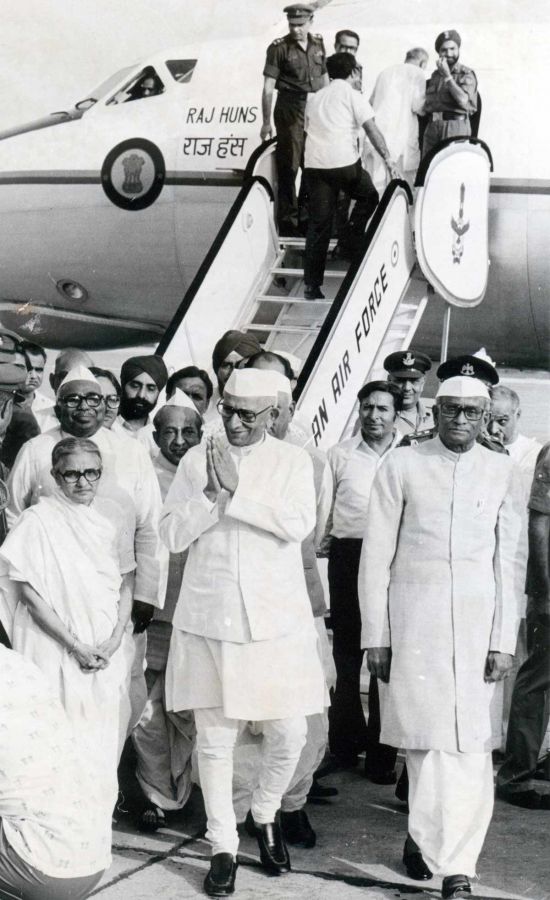
When he returned to New Delhi, he was received by then President Neelam Sanjiva Reddy, then Vice-President B D Jatti, central ministers and others. Photograph: Rediff Archives
It was the night of 4th of November 1977, around 2000 hrs.
Dancing flames from the still running right engine was a blessing in disguise in the pitch dark of the night. The aircraft had lost its left wing and its attached engine as it had flown through into a thick branch of a tree while on final approach to the runway.
The subsequent crash of the aircraft had been cushioned by the tall bamboo grove growing wild in that area and the soft slushy ground, wet due to the recent rain.
Whilst the rear portion of the aircraft that housed the passenger cabin was almost intact, what remained of the nose and cockpit area was a mangled mass of metal and a million wires.
It was impossible to ascertain if the crew were safe, but that did not seem very likely.
The Tupolev 124, christened Pushpaka, was one of the three in the Indian Air Force inventory of the Communication Squadron (Comn Sqn) based at Palam.
The squadron had an enviable task of transporting VIPs across the entire span of our nation as well as on international trips.
Pushpaka was airborne late in the evening hours from Delhi to Jorhat in Assam with then prime minister Morarji Desai and his entourage for what was to be its final flight.
Other members of the prime minister's entourage included his son Kanti Desai, Prem Khandu Thungaon, then the chief minister of Arunachal Pradesh, John Lobo, then the director, Intelligence Bureau, and a few journalists.
The aircraft was commandeered by Wing Commander Clarence Joseph D'Lima with Squadron Leader Mathew Cyriac as his copilot. Other crew were Wing Commander Joginder Singh (Navigator), Squadron Leader V V S Sunkar (Flight Engineer) and Flight Lieutenant O P Arora (Flight Signaller).
Flight Lieutenant Puthalath Kandy Raveendran, an additional flight engineer on board, was to be trained on the return leg and hence sitting at the rear of the aircraft.
This is his first-hand account of what happened on that fateful flight as narrated to Air Commodore Nitin Sathe (retd).

Though November usually brings clear weather to the North East, that year was marked by heavy rains and thunderstorms, reducing visibility to almost zero.
Despite being equipped with state-of-the-art avionics, the Tu-142 faced a significant challenge: The Jorhat airfield lacked the relevant landing aids and infrastructure needed for a safe landing under such adverse conditions.
The runway's basic lighting consisted of World War-era goose-neck flares -- kerosene-filled containers with burning wicks -- placed along the runway to guide pilots to align the aircraft for landing and a rudimentary Non-Directional Beacon (NDB) which was helpful in approaching the airfield and not of much use for landing.
As the aircraft entered the eastern airspace, a critical decision loomed. Fuel reserves were a decisive factor -- once the aircraft descended from cruising altitude for landing, it was committed to touching down either at its destination or a nearby airfield.
Returning to Calcutta, which had the necessary landing aids, was no longer an option.

After carefully weighing the odds, the captain and his crew decided to proceed with the descent and attempt a landing at Jorhat.
Carrying a VIP on board often adds immense pressure to decision-making. Operational delays that impact a VIP's schedule can invite scrutiny and difficult questions.
This added pressure likely weighed heavily on the crew as they made the high-stakes decision to commit to landing at Jorhat.
In the first approach for landing, the very experienced captain, Wing Commander D'Lima, was unable to align to the runway and had to go around to execute another approach for landing.
The weather had deteriorated further by the time the aircraft came in for its second approach with visibility almost dropping to zero.
The aircraft finally met its end about four kilometres short of the runway near a small village Tekelagaon. Luckily, no one on ground suffered any injury.
The cabin plunged into darkness at first impact; and as the aircraft came to a stop, fuel fumes and smoke in engulfed the area making even breathing difficult.
In the dark of the night, the passengers were disoriented, in panic, and did not know what was to be done.
Wing Commander Raveendran and flight steward Sargeant Iyer, though shaken and injured, managed to open the rear door of the aircraft and shouted for the passengers in the forward cabin to exit in haste since they suspected that fire would engulf the aircraft.
And while this evacuation was happening, the flames from the burning engine suddenly died, pitch darkness engulfing the entire area.
After all passengers were safely out, Raveendran decided to attempt to get into the cockpit area once again in an attempt to rescue the crew, shouting their names as he went about his task.
Prime Minister Morarji Desai and his entourage were led by some of the ground crew to the village leaving Raveendran and Corporal Upadhaya, a technician, with the remains of the aircraft.

After a while, some villagers approached the crash site with makeshift burning torches, and Raveendran and Upadhaya had a difficult time explaining to them that the embers from their torches could lead to a major fire in the jet fuel-soaked surroundings.
In one final attempt, Raveendran attempted getting into the mangled cockpit area from the outside with the help of the villagers, but did not find success. There was no sign of life inside the cockpit.
Raveendran now became aware of excruciating pain in his knee and could barely walk. He felt it swelling up quickly. His knee had taken a bad knock during the crash, but the rush of adrenalin had prevented him to notice the same during the rescue efforts.
Much later, the bodies of the crew were found a distance away from the crash site. It was conjectured that as the tree had ripped the nose landing gear away, it resulted in creating a big hole at the bottom of the cockpit floor, sucking away the crew before the aircraft plunged to the ground.
Meanwhile, at Jorhat, emergency actions for rescue had begun but there was no clarity where exactly the aircraft had crashed.
Raveendran and Corporal Upadhaya decided to seek help from the locals to reach the IAF base and get the rescue teams to reach the site.
In the darkness of the night, an old rickety jeep belonging to a villager tried to take them through the slush but got bogged down after traveling a few yards.
The villagers then managed two cycles on which they got to a road only to be helped by some people traveling in a tempo to reach the gates of the base at Jorhat.
What followed was recounting of the accident many times over to different people who visited them while they convalesced at the small hospital inside the air force station.
A court of inquiry was instituted to investigate into the causative factors leading to the accident.
Over the next few days, the press covered Moraraji Desai's miraculous escape and the minor injuries suffered by him and others in his entourage.
Sadly, the death of the crew and the heroics of the other crew, including that of Raveendran in rescuing them, did not find place in the reports.
It was only after the court of inquiry brought out the complete story of their rescue efforts, that Raveendran and Upadhaya were awarded the Shaurya Chakra by President Neelam Sanjiva Reddy on January 16, 1979.

Exactly 40 years later to the day, IAF Veteran Raveendran visited the crash site to pay homage to the valiant crew of the aircraft who lost their lives and saved so many on board the ill-fated flight.
Raveendran was pleasantly surprised to notice that the villagers in the area had not forgotten the tragedy even after four decades.
Bitopan Borah, the son of villager Tarun Chutia who had helped Raveendran with the aborted ride in his jeep, was there to meet them along with some local journalists and politicians.
Borah had been in touch with the authorities for many years to build a memorial in memory of the crew of the Pushpaka as well as getting the authorities to follow up on the promises made by the VIP passengers when they were looked after by the villagers that night after the crash.
He had yet not found much success over the years, but hoped that with this visit, some recognition as well as schemes for betterment of the village would follow.
With his persistent efforts, the crash site in Takelagaon once again saw a mockup of the Pushpaka that year, made of bamboo and hay.
Possibly, the bamboo was from the same stock that had saved the aircraft from smashing into pieces that fateful night.
Wing Commander Raveendran today lives in Bengaluru enjoying his retired life.
Born in a small village in Kozhikode district, Raveendran was the youngest of seven children born to the family.
He went on to complete his engineering and tried his hand at a few jobs before trying for the armed forces.
His attempt at joining the Indian Navy was unsuccessful at first, but with motivation from his brother who was an airman in the IAF, he attempted again and found success, thus beginning a long innings in aviation in July 1971.
"While studying at REC Calicut," he recalls, "my fascination for aircraft grew manifold. We had a aeromodelling club in our college where I took keen interest in building and flying model aircraft.
"In fact, in one of the study tours to Bombay, while all my friends enjoyed the sights and sounds of the bustling city on a free day, I preferred to go to Santacruz airport and spend all my time watching aircraft take off and land."

Training at the Air Force Technical College at Bengaluru, he proved that he was the best of the best by topping the course.
The veterans of those times know Raveendran as a no nonsense, highly professional, intelligent and motivated officer who knew every nut and bolt of the aircraft that he worked on. thereby earning respect of all those who worked alongside him.
"I even got my Para Wings by doing jumps from the C-119 Packet aircraft at Agra. I think I was the first of the engineering branch to get two wings -- one as a parachutist and one when I did my PPL (Private Pilot License) at the Jakkur Flying Club whilst pursuing my MTech."
Keen on being in the cockpit, Raveendran volunteered for the flight engineer's course after which he was posted to 118 Helicopter Unit at Guwahati, his dream of flying inside a cockpit fulfilled.
Later, he moved to the Communication Squadron at Delhi to fly as engineer on the TU124.
Around the time of the crash, Raveendran had been selected to go to France to do the prestigious Flight Test Engineer course at the EPNER.
Thankfully his knee injury healed fast enough for him to go for the same.
"I mastered French and did some very interesting and ingenuous projects during my training which helped me pass on top of my class!"
Back in India, he was at the Aircraft Systems testing Establishment (ASTE) at Bangalore, putting all the theory that he learnt in France into practice, testing new systems to be used on future aircraft of the IAF.
He was actively involved in the design and development of the LCA Tejas fighter aircraft even after he left the IAF.

Air Marshal Philip Rajkumar, his boss at the National Flight Test Centre says, "I worked closely with Ravi for nine years in the LCA programme."
"As a graduate of the French Flight Test School (EPNER) he was the lead flight test engineer at the NFTC for 20 years. He provided the much-needed continuity to the Test programme as he was at the telemetry console from the first engine ground run till the Initial Operational Capability was granted."
"The outstanding safety record of the test programme was in large measure due to Ravi's stewardship".
After he hung up his boots and went into retirement, whilst on a trip to meet his daughter in the US, he had a surprise gift waiting for him on his 75th birthday.
She had arranged for a one-hour flight with an instructor pilot at Palo Alto.
"I was so excited to be back at the controls for an hour almost 20 years post-retirement. The instructor let me do everything and was quite impressed with my flying skills!"
Have you had a close tryst with death other than the one you narrated?

"Oh yes! I am quite accident prone. Another bad accident that almost took my life was on the night i was proceeding back from Chennai after a job interview.
"The steam locomotive of our train developed a technical snag, stalling somewhere near the town of Perambur. In a short while, another express train travelling at full speed rammed into our train from behind. My coach was flung into the air and crashed on its side. There was chaos and darkness in the cabin, made worse by water gushing from the ruptured overhead tanks into our compartment."
A lot of his fellow passengers died in this tragedy, but Raveendran was lucky. He, with help of another co-passenger -- an army man -- rescued some of the injured from the mangled remains of the bogie.
"I almost lost all my certificates during this accident. After the rescue, as I walked away from the train, I realised that my belongings were left behind inside the compartment. A lot of people had appeared at the scene and appeared to be pillaging from the debris."
"I rushed back through this crowd to my compartment and was lucky to find my possessions, especially the packet containing my certificates! If I had lost those that night, who knows, I may not have joined the IAF and had this beautiful journey!"
"During flying, I have been through many unpleasant situations, especially while fighting the weather in the North East. I was lucky to fly with expert pilots who always got us out of the soup!"
Feature Presentation: Aslam Hunani/Rediff.com


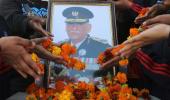

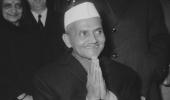



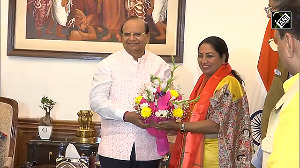
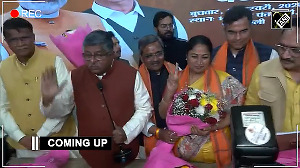
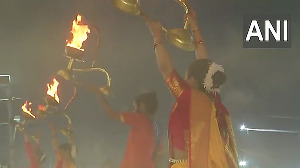
 © 2025
© 2025